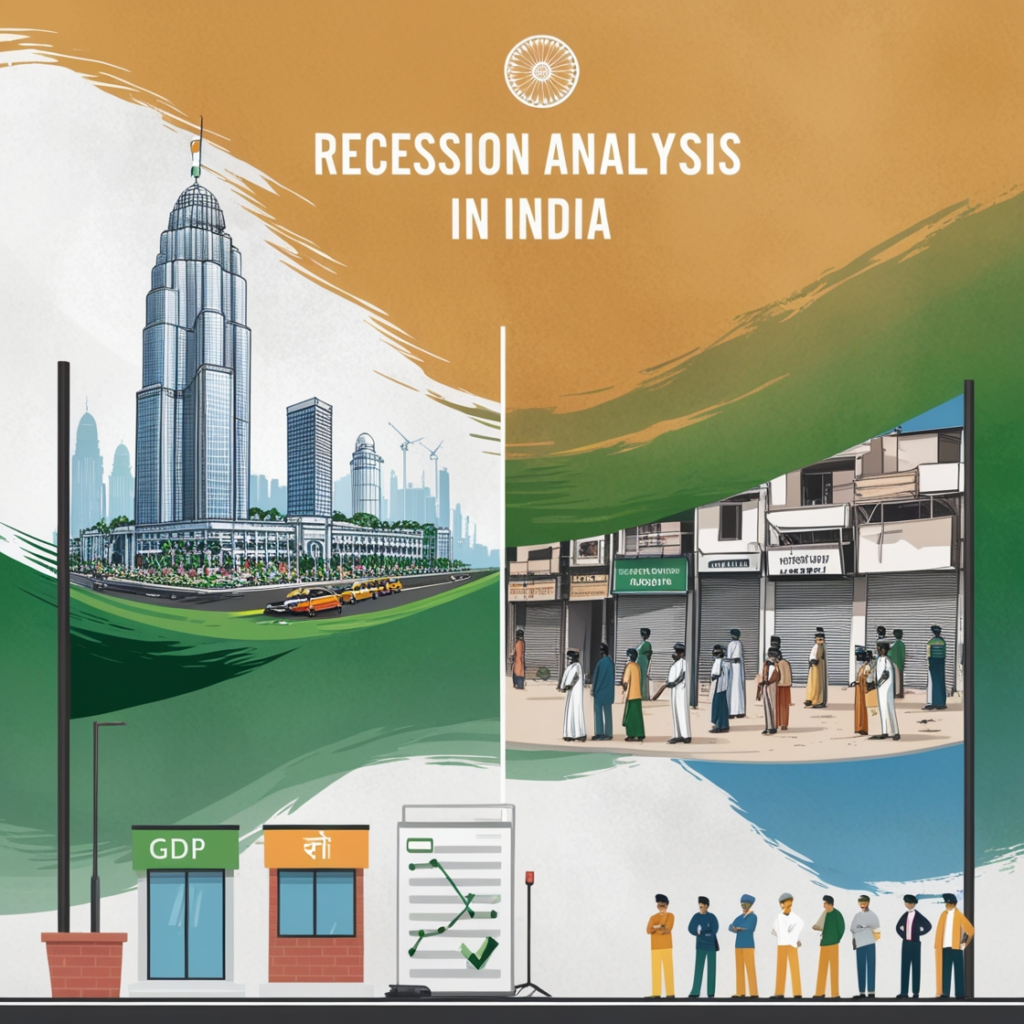The current recession in India continues both domestic and global employment, consumer expenditure, SME business, and investment suffering. Higher inflation poses more problems to the economy and while the action taken by the government has merits they tend to lack the ability and capacity to solve deep structural problems. As we move through this downturn, it requires all stakeholders across the government, private sector, and civil society to come together and create a society that can bounce back and rebuild itself.

Introduction
Fear associated with the term “recession” can easily be connected with such terms as crisis, instability, and uncertainty on the economy level. By extending a simple definition of recession to the Indian economy we have realized that recession has direct impacts on the different sectors and classes of the Indian economy.
Causes of the Recession in India :-

1. Global Economic Slowdown
International market integration is evident in the vulnerability of India’s economy. The condition is that when major economies of the world include the United States or China slows down, then India is affected by it as well. Many factors are responsible for this situation such as the decline in international demand for the Indian exports, the decline in flow of foreign investment and global interruption in the supply chain.
2. Domestic Policy Challenges
The following is an indication that; Economic policies of every country also give the picture of its economic status and growth including the Asia’s giant-India. This implies several short term factors like GST, demonstration and the NPA problem in the banking sectors have policies that are disruptive in nature. In the meantime, it has not been very easy to implement such policies in the short run but they are essential for creating the economy.
3. Agricultural Distress
Agriculture in India is one of the corner stones of Indian economy by providing employment to a larger lot of the population. From the poor monsoon seasons poor crop pricing and inadequate support system, distress has developed in the agricultural sector. This trickle down distress percolates to rural demand and subsequently affects overall economic growth.
Impact on Different Sectors :-
1. Manufacturing Sector
Manufacturing has been under pressure especially during the period of recession. Customers are spending less, there are disruptions in the supply chain, and industrial outputs are low, and this has all caused slow down. SMEs operating in this sector have been heavily affected, they are faced with cash flow problems, and reduced sales.
2. Services Sector
India based IT, retail, tourism and other service sectors have also been affected too. The slowdown of the world economy has affected the Information Technology industry particularly by decreased demand for out sourcing. Worries over travel and spending remain a headwind for the tourism industry which has been dealt a further blow by COVID-19 impact.
3.Recession in employment
The situations of low income and job insecurity thus scaled down expenditure in the economy. This leads to reduced demand for commodities, which has an implication on the business firms and results into low production, job losses and still slower economic growth.
4. COVID-19: The Peak of India’s Economic Recession
During the COVID-19 pandemic, India faced an unprecedented economic crisis, marking one of the most severe recessions in its history. The nationwide lockdown, disrupted supply chains, and massive job losses compounded the existing economic challenges, leading to a significant contraction in GDP and affecting millions of livelihoods.
Government Measures to Mitigate the Recession:
1. Fiscal Stimulus
Indian government has so far come out with several fiscal measures to boost the economic activities. They are cash transfer to targeted group such as , tax cutter, and subsidies for companies. The idea is to increase spending, help enterprises, and save jobs.
2. Monetary Policy
Investment transfers of these equalizes are made by the Reserve Bank of India (RBI), which has also implemented some measures for the monetary policy. Some of these consist of cut in interest rates, resort to liquidity support to banks and credit measures to important sectors. These measures are made to force economic activity and assist in the restoration.
3. Support for MSMEs
MSMEs are the lifeline of the Indian economy which play a major role in the development of the nation. There are specific initiatives offered by the government in recent years including loan without collateral, credit guarantee and funds to the MSMEs. These should be used to keep and build these enterprises during the recession period.
4. Recession in agricultural Reforms
In a bid to tackle problem of distress in the agricultural sector, the government has embarked on the following reforms. These are availing markets, input-output credits and support infrastructure in agriculture. The rationale of the government’s policy is to bring higher revenues of the farmers and track the steady development of the agricultural industry.
Long-term Strategies for Economic Resilience
1. Enhancing Infrastructure
Infrastructure expenditure can provide the necessary boost to the economy if well planned, could also catalyse the creation of productive employment opportunities. Investing in transport infrastructure; Information communication technology; and social infrastructure enhances the production processes thus aiding in long-run economic development.
2. Promoting Innovation and Entrepreneurship
Promoting of innovation and entrepreneurship development would spur the economy and also create employment. Truly encouraging new business opportunities, funding research and development as well as ensuring a good environment for business is cruciality for a vibrant and sustainable economy.
3. Strengthening Social Safety Nets
These programmes can help guard the most susceptible communities against the worst affects of an economic downturn. It’s important to explain how to reduce the social cost of recessions by increasing social security and health care and food security.
Conclusion of recession
The experience of the recession in India proves that the processes of economic recovery require a complex approach. In order to develop the protection and future stability of transportation infrastructure, it is necessary to undertake the fight against the root causes, provide help to vulnerable sections, and integrate sustainable solutions that need to be implemented for the economy to become as strong as possible. Nevertheless, taken together, the threats are rather severe but with the proper polices and actions, India will be able to steer her through the recession.




Leave a Reply
You must be logged in to post a comment.